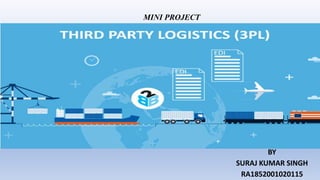
3 PL Slideshare
- 1. Logistics & Supply Chain Aspects In Retail Management 3RD PARTY LOGISTICS BY SURAJ KUMAR SINGH RA1852001020115 MINI PROJECT
- 2. What is 1PL and 2PL? • A first-party logistics provider (1PL) is a firm or an individual that needs to have cargo, freight, goods, produce or merchandise transported from a point A to a point B. The term first-party logistics provider stands both for the cargo sender and for the cargo receiver. A 1PL can be a manufacturer, trader, importer/exporter, wholesaler, retailer or distributor in the international commerce field. It can also be institutions such a government department or an individual or family removing from one place to another. Anyone having goods moved from their place of origin to their new place is considered to be first party logistics provider. • A second-party logistics provider (2PL) is an asset-based carrier, which actually owns the means of transportation. Typical 2PLs would be shipping lines which own, lease or charter their ships; airlines which own, lease or charter their planes and truck companies which own or lease their trucks
- 3. THIRD PARTY LOGISTICS • Third-party logistics involves the utilization of external organizations to execute logistics activities that have traditionally been performed within an organization itself. • for example, a company with its own transport facilities decides to employ external warehouse specialist, this would be an example of third party logistics.
- 4. Reasons why using 3PL can help to run a business more efficiently. • Outsourcing logistics, first and foremost, helps a business preserve valuable time. • Outsourcing to a Third-Party Logistics Provider can also create shared responsibility for the business • The 3PL can share responsibility for a variety of services, such as supply chain management and locating economies of scale.
- 5. Level of outsourcing • Transactional Outsourcing: Based on transactions, with no long term contracts and no bonding between the 3PL and the outsourcing company. • Tactical Outsourcing: Outsourcing on a long term basis with negotiated contacts and integrated IT systems to facilitate free information flow and create supply chain visibility. • Strategic Outsourcing: Based on long-term relationships with successful outcomes, 3PL companies become partners in supply chain management and establish transactional transparency.
- 7. TYPES OF 3PL PROVIDERS 1. Standard 3PL provider 2. Service developer 1. The customer adapter 2. The customer developer
- 8. • Standard 3PL provider: this is the most basic form of a 3PL provider. They would perform activities such as, pick and pack, warehousing, and distribution the most basic functions of logistics. • Service developer: this type of 3PL provider will offer their customers advanced value-added services such as: tracking and tracing, cross-docking, specific packaging, or providing a unique security system. A solid IT foundation and a focus on economies of scale and scope will enable this type of 3PL provider to perform these types of tasks.
- 9. • The customer adapter: this type of 3PL provider comes in at the request of the customer and essentially takes over complete control of the company’s logistics activities. The 3PL provider improves the logistics dramatically, but do not develop a new service. The customer base for this type of 3PL provider is typically quite small. •The customer developer: this is the highest level that a 3PL provider can attain with respect to its processes and activities. This occurs when the 3PL provider integrates itself with the customer and takes over their entire logistics function. These 3PL providers will have few customers, but will perform extensive and detailed tasks for them. This is the case where a 3PL provider can becomes a 4PL provider. They have become so integrated that they now share in risk and rewards with their customer.
- 11. Major Advantages and Disadvantages • Advantages • To save time • Because someone else can do it better • To re-engineer Distribution Network • Economies of scale and scope • Saving on capital investment • Focus on core competency • Improved efficiency, service and flexibility • Disadvantages • Searching efforts • Coordination efforts • Information sharing • Loss of control
- 12. Non Asset-based Logistics Providers • Advancements in technology and the associated increases in supply chain visibility and inter-company communications have given rise to a relatively new model for third-party logistics operations – the “non-asset based logistics provider.” Non-asset based providers perform functions such as consultation on packaging and transportation, freight quoting, financial settlement, auditing, tracking, customer service and issue resolution. • To be useful, this type of provider must show its customers a benefit in financial and operational terms by leveraging exceptional expertise and ability in the areas of operations, negotiations, and customer service in a way that complements its customers' preexisting physical assets.